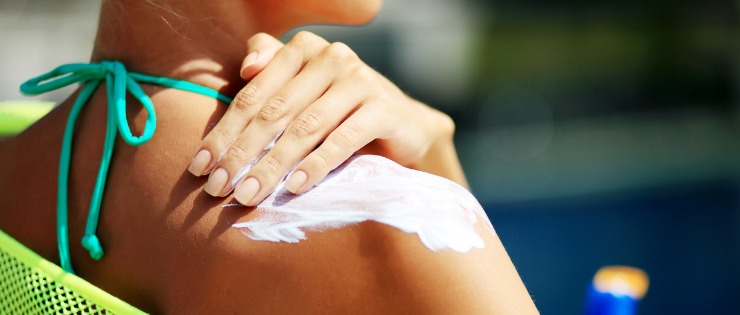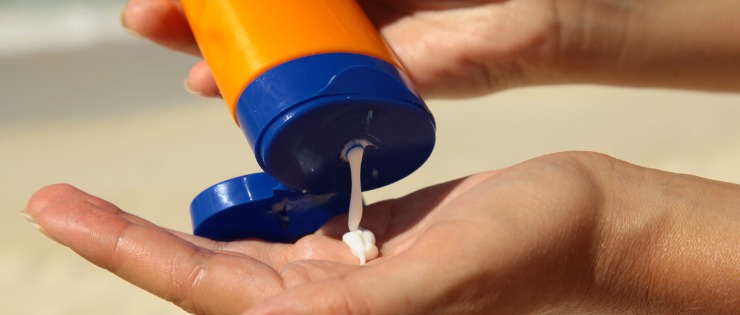
The SunSmart message is getting through and we are slopping on sunscreen like never before. To protect ourselves from UV rays that can cause skin and eye damage, sunburn and skin cancer, many Australians are using sunscreen on a daily basis. As people become more health conscious, some are opting for screenseen that is promoted as being “natural sunscreen” and “non-toxic”.
So what ingredients are actually in our sunscreen and what harm they could be doing us?
Some ingredients in sunscreens have been in the spotlight in the past decade as potentially dangerous to human health. While all Australian sunscreens are approved by the TGA and considered non-toxic and safe, is there a more natural sunscreen you should choose over another?
What is Sunscreen Protecting us From?
Firstly - what’s the point of sunscreen and why should we wear it? Ultraviolet (UV) radiation is a type of energy produced by the sun. The human body cannot detect UV radiation as it can’t be felt, however it is measurable. The Bureau of Meteorology provides a daily UV level and advises the times we should use sun protection, usually when UV levels are three or more. It only takes 10 minutes for your skin to burn when the UV is high or extreme.
While we need some UV exposure to produce vitamin D in the body, too much can cause sunburn, skin and eye damage, premature ageing and skin cancer.

Difference Between UVA and UVB rays
Sun is a combination of UVB and UVA rays. The SPF measures protection against UVB rays however in recent years research has shown UVA rays are just as damaging to the skin. UVA rays penetrate the skin deeper than UVB causing discolouration, sagging and wrinkling of the skin and cancer. UVA are more plentiful than UVB and are strong throughout the day and year. Unlike UVB rays, UVA exposure doesn’t have the warning sign of sunburn.
There are sunscreens that offer protection against both UVA and UVB rays. Known as broad-spectrum sunscreen, they have UVA-filtering ingredients called Tinosorb S and Tinosorb M.
What Does the SPF of Sunscreen Mean?
The Sun Protection Factor (SPF) is the measurement of how well a sunscreen protects skin from UVB rays. If your skin usually burns after 10 minutes in the sun applying an SPF 15 sunscreen allows you to stay in the sun for roughly 150 minutes.
Using an SPF 50+ sunscreen doesn’t give you more than three times the protection of an SPF 15 sunscreen as you might assume. The increased protection is just 5%.
An SPF 15 sunscreen blocks 93% of UVB rays
An SPF 30 blocks 97% of UVB rays
An SPF 50 blocks 98% of UVB rays
Sunscreens with a very high SPF of 75 or 100 offer little extra protection. In fact, they often lead people into having a false sense of protection. These high SPF sunscreen offer UVB protection but not UVA protection.
A sunscreen is only as effective as the amount you apply. Most people don’t apply enough sunscreen, often just one quarter to a half of the recommended amount. By applying half the recommended application of an SPF 30 sunscreen, you will only have an effective SPF of 5.5.
To ensure full sun protection, adults should apply two to three tablespoons of sunscreen on their body and one teaspoon on their face and rub it in so there is an even layer all over.
How does Sunscreen Work and What Chemicals Are In It?
Sunscreen protects the skin from damaging ultraviolet (UV) radiation produced by the sun in one of two ways.
Chemicals in sunscreen act as filters by binding with the cells in the skin absorbing UV radiation and dispersing it as heat before it can damage the cells. They refer these sunscreen components as ‘organic’.
Physical filters in sunscreen contain micro-fine particles that sit on the surface of the skin and act as a physical barrier against the sun. The particles deflect and scatter the UV rays and are ‘inorganic’. Sunscreen can contain either chemical filters, physical filters or both.
Sunscreens are classified into two groups - chemical absorbing or physical filtering.

Chemical Absorbing Sunscreens
Chemical sunscreens have a greater ability to filter UVB and UVA rays, providing a higher SPF rating than most natural (physical filtering) sunscreens. All chemical ingredients in Australian sunscreen have passed strict regulations imposed by the Therapeutic Goods Administration (TGA). However, some people have concerns about the number and types of chemicals found in sunscreens. Two chemicals with high toxicity concerns include oxybenzone and octinoxate.
Oxybenzone is very effective in absorbing UVA and UVB rays and dispelling them as heat but the American Environmental Working Group (EWG) rates oxybenzone with an eight out of 10 hazard score. The EWG has made claims that oxybenzone can alter hormone levels in rats, cause high skin allergy rates, and residue is in most tested human bodies and mother’s milk. However, oxybenzone has been an FDA-approved ingredient for sunscreen since 1980. Octinoxate has a hazard rating from EWG of six out of ten with similar concerns.
The Australasian College of Dermatologists says “there is currently no scientific evidence demonstrating long-term side effects including any hormonal effects, following regular use of sunscreen.”
Physical Blocking Sunscreen (Natural Sunscreen)
Physical blockers are ‘natural sunscreens’ also known as mineral or organic. Some consumers see them as a non-toxic, healthy alternative to chemical sunscreens however they have had their own controversy in the form of nanoparticles. The active UV-filtering ingredient in natural sunscreens is usually micronized titanium dioxide or zinc oxide. Both ingredients are in sunscreen for their ability to filter UVA and UVB radiation.
High-SPF mineral sunscreen use titanium dioxide and zinc oxide which aren’t completely absorbed into the skin, leaving a physical barrier. These barrier sunscreens are ideal for children under the age of two and adults with allergies to chemical sunscreen. However, some consumers don’t like the ‘white appearance’ of sunscreens with high quantities of titanium dioxide and zinc oxide.
Safety of Nanoparticles in Sunscreen
With consumer pressure to reduce the white look of zinc oxide and titanium oxide sunscreens, manufacturers reduced the size (micronised) of the particles so they were less detectable on the surface of the skin. While the particles only need to be micro-fine, the manufacturing process can reduce the size of some particles (usually less than 1% of the product) to nano-size. Nanoparticles are smaller than 100 nanometres (a nanometre is 0.000001 millimetre).
We have debated the safety of nanoparticles in sunscreen for more than a decade following in-vitro research found that zinc oxide (ZnO) and titanium dioxide (TiO2) nanoparticles can cause free radical formation (likely hydroxyl radicals through oxidation). Sunscreens have included nano-sized TiO2 since 1990 and nano-sized oxide since 1999. The TGA has reviewed the evidence on multiple occasions and found the nanoparticles stay on the outer layer and surface of the skin and don’t reach viable skin cells. The TGA issued this policy on the safety of nanoparticles ingredients in 2009.
Following a review of literature published in the three years to 2016 the TGA issued an updated review which concluded that the majority of studies have shown that both ZnO and TiO2 nanoparticles either do not penetrate or minimally penetrate the stratum corneum (outermost layer) and underlying layers of skin.
Cancer Council Australia also issued the findings in a 2014 report that human immune cells that exposed to zinc oxide nanoparticles can absorb and break down the nanoparticles.
Australian Regulatory Guidelines for Sunscreen
The Therapeutic Goods Administration (TGA) developed the Australian Regulatory Guidelines for Sunscreens in consultation with the National Industrial Chemicals Notification and Assessment Scheme (NICNAS), the pharmaceutical and cosmetics industries. Therapeutic sunscreens are evaluated by the TGA for quality, safety and efficacy as registered therapeutic goods. Sunscreens must comply with SPF testing, stability (expiry) testing, labelling, and advertising requirements.
The regulations list all permitted active ingredients and the maximum concentration allowed. There are 30 approved sunscreening active agents from bemotrizinol with a 10% maximum concentration to zinc oxide with no concentration limit. If a manufacturer wants to include an active ingredient not on the list, they must submit data to establish its safety and efficacy.
Should You Make Your Own Natural Sunscreen?
With the movement towards healthy, clean living, and avoiding chemicals people around the world have researched making their own natural sunscreen using natural ingredients. The internet is littered with recipes for homemade sunscreens that claim to work. Ingredients vary from almond and red raspberry seed oil to zinc oxide and everything in between.
However, DIY comes with its own risks. Sure, the ingredients are non-toxic but dermatologists have issued warnings about making your own sunscreen. Many recipes use oils that actually absorb light, making UV rays penetrate the skin more. Just as previous generations slathered on the baby oil before sun baking, some DIY sunscreen ingredients are effectively doing the same.
Tests on commercial sunscreens in the lab ensure they provide a broad spectrum protection and that ingredients are stable and active after mixing and heating in the sun. No one can test a DIY sunscreen at home in the same way.
Even the EWG has issued a warning about DIY sunscreens saying consumers don‘t know what the SPF is and preparing mineral sunscreen is dangerous because zinc and titanium bought online are dangerous if inhaled.
If you want to avoid chemicals, choose a commercial sunscreen that uses zinc oxide or titanium oxide. You won’t know if it uses non nano zinc oxide as the active ingredient but it will work to block the UV rays.
Using Sunscreen is Much Safer than Possible Risks of Not Using
There’s no doubt, sunscreen is confusing to the average consumer. For a start, chemical sunscreens are called organic while physical sunscreens are inorganic. It makes no sense and then there are the safety concerns about some ingredients that worry some people. But the fact remains, sunscreen prevents skin damage and cancer.
Cancer Council Australia published research in 2015 that showed Australians prevented over 1,700 cases of melanoma and 14,000 cases of non-melanoma skin cancer because of regular sunscreen use in the decade to 2010.
According to Choice Australia any sunscreen (with or without nanoparticles) is safer than not using sunscreen. The evidence shows that any nanoparticles in sunscreen aren’t absorbed into the body like the sun’s damaging rays which can lead to skin cancer.

SunSmart Message
Remember the SunSmart message isn’t just about applying sunscreen; that’s just one part. Several years ago the sun protection message of Slip Slop Slap expanded to Slip Slop Slap Seek Slide.
Slip on sun protective clothing.
Slop on sunscreen with an SPF 30 or higher at least 20 minutes before exposure to the sun and reapply every two hours, or more if swimming or perspiring.
Slap on a broad-brimmed hat to provide shade protection to the face, neck and ears.
Seek shade.
Slide on sunglasses.
If you follow this sensible message, you can enjoy your time outdoors without risking your skin.